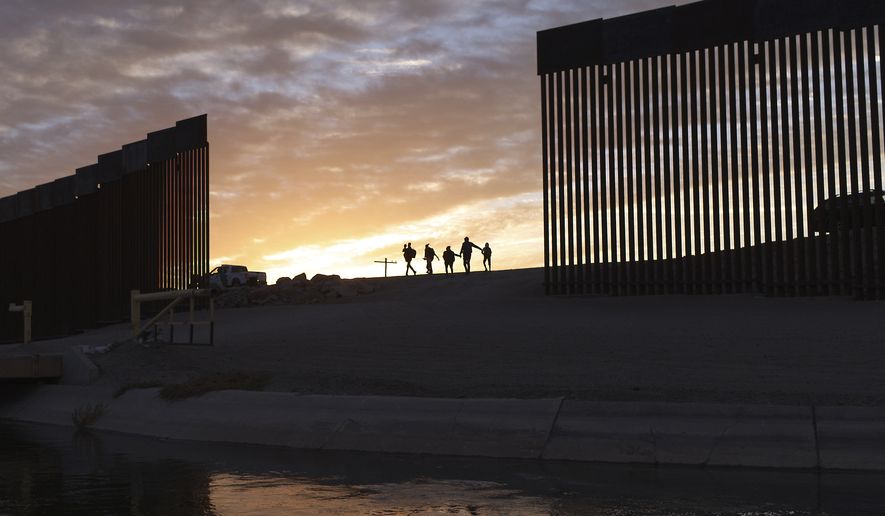More than 1.3 million people are currently awaiting deportation decisions in immigration courts, and the average case has been pending for nearly three years, according to new data that sheds light on just how broken the U.S. immigration system has become.
A decade ago just 300,000 cases were pending, and even three years ago it was fewer than 770,000 cases, meaning the government has netted more than 550,000 cases on its docket since 2018, according to the Transactional Records Access Clearinghouse at Syracuse University.
Jessica Vaughan, policy studies director at the Center for Immigration Studies, said the growth is a sign of just how lax America’s border controls have become, and how immigrants who are in the country illegally have gotten good at exploiting loopholes, demanding lengthy court proceedings when previously they would have quickly been ousted.
“There simply are more people who are allowed to have immigration court hearings instead of being processed in an efficient manner, such as expedited removal or other choices that ICE has,” Ms. Vaughan said. “Frankly, most of these cases don’t belong in immigration court, or if they are, it should be on a rocket docket, because they have no legitimate claim to stay; they are gaming the system.”
She said it’s become “absurdly difficult” — not to mention costly — to oust someone who wants to fight a removal. And that’s fueling the current border surge.
TRAC has calculated that even if immigration enforcement was suspended altogether and no new cases were added from either the border or the interior, it would take more than four years to work through the backlog.
In fact, new cases are being added at a brisk pace, at least from the border, where the Biden administration is facing an unprecedented surge.
Immigration courts are staffed by administrative law judges, employees of the Justice Department, and they handle civil immigration matters such as asylum decisions, bond hearings and deportation decisions.
TRAC says there were 1,290,766 cases pending in those courts as of the start of the year. By the end of May, which was four months into the Biden administration, it had risen to 1,337,372 cases, or an increase of more than 46,000.
The average case has been pending for 946 days. Some cases date back decades, and were brought by the Immigration and Naturalization Service, an agency that ceased to exist in 2003, when Homeland Security was created.
California has the most people stuck in the backlog, with 193,212, followed by Texas at 171,579. In terms of courtrooms, Texas has the most pending cases with 213,254, followed by California at 198,785.
Those two states also represent two poles of the immigration spectrum, with California being an avowed sanctuary state and Texas adopting strict anti-sanctuary policies that force cooperation between local authorities and U.S. Immigration and Customs Enforcement.
Ms. Vaughan said it makes sense that the jurisdiction that is more pro-enforcement would have more cases.
She said in those places, ICE has been able to make more arrests because of cooperation from local authorities, so there are more people in the pipeline. Texas also has more ICE field offices processing cases, she said.
While Texas and California have the most cases, as a percentage of their estimated undocumented immigrant population they don’t crack the top 10.
Louisiana leads on that account, with TRAC reporting nearly 32,000 deportation cases pending in a state with just 70,000 undocumented immigrants, according to the Pew Research Center’s latest estimates. That works out to about 45% of the undocumented immigrant population in Louisiana.
Kentucky, Nebraska, Missouri and Massachusetts round out the top five.
TRAC, in its own analysis, said having access to a lawyer correlated to longer case times, and said migrants represented by lawyers also tend to do better in their cases.
Immigrants have lawyers in just 46% of cases in Texas, compared to 79% in New York and 77% in California.
Ms. Vaughan, though, said she’s not convinced lawyers are the reason the backlog has surged.
Instead, she pointed to policy changes during the Obama years, which correlated with a change in the flow of people coming. Previously it had been almost exclusively Mexican, but it became heavily Central American, with children and families making up a significant portion.
The TRAC numbers do show that case levels were fairly static during the Bush years, then began a steady rise from 2009 on.
Ms. Vaughan said the Obama administration started allowing asylum seekers to be released pending their cases, which allowed them to be free in the country, burrowing into communities. The message eventually trickled back home to Central America.
“It took a while before the migrants, smugglers and advocates realized how this could be worked to the advantage of an illegal border crosser, and then eventually the huge numbers of minors and families began showing up, and the numbers on the docket exploded,” Ms. Vaughan said.
Jon Feere, a former chief of staff at ICE who now works at the Center for Immigration Studies, said part of the reason the caseload grew under President Trump was that a number of cases shut down in the Obama years were reopened.
The Biden administration, though, is closing out cases again, he said.
“These administrative closures simply encourage more illegal immigration,” Mr. Feere said.
• Stephen Dinan can be reached at sdinan@washingtontimes.com.




Please read our comment policy before commenting.